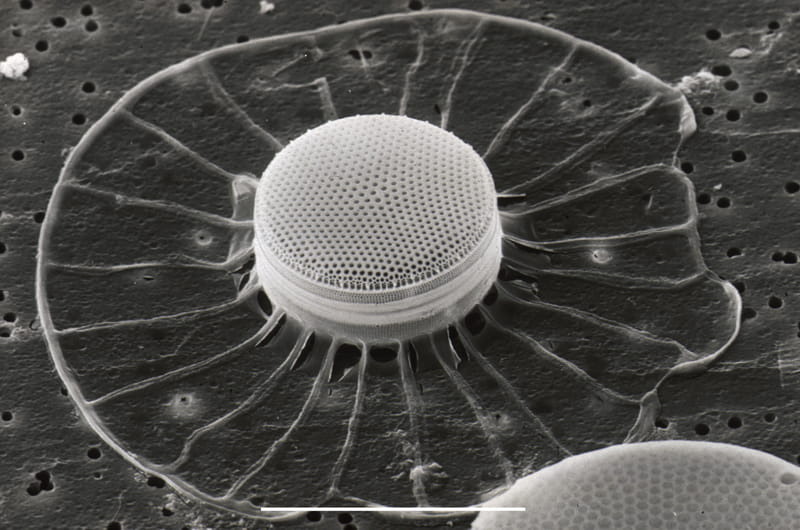Tiny Algae Ideal for Sniffing Out Nutrient Pollution in Water
 By Frank Otto
By Frank Otto

- Drexel Selects New, World-Class Life Sciences Building at 3201 Cuthbert Street for Medical Research Operations
- Breakthrough on Gene Therapy for Hereditary Spastic Paraplegia
- Drexel Environmental Collaboratory Releases Cross-Sector Findings on Severe Weather Recovery Challenges
- How and When Could AI Be Used in Emergency Medicine?

The key to effectively measuring damagingly high levels of nutrients in freshwater streams lies in the microscopic organisms living in them, according to a group of Drexel University scientists.
A team largely made up of researchers from the Academy of Natural Sciences of Drexel University analyzed data from 1,400 freshwater Mid-Atlantic streams to see whether a group of tiny algae, called diatoms, might be efficient indicators of overly high nutrient levels — termed eutrophication.
What they found was a new way to use diatoms’ particular sensitivity to nutrients as a measuring stick.
“The diatom biological condition gradient (BCG) has an advantage over other nutrient indicator metrics because it can be used to identify boundaries along the nutrient concentration gradient that separate unimpaired from impaired sites,” said Don Charles, PhD, section leader of Phycology at the Academy and a professor in the College of Arts and Sciences.
The research was published in Science of the Total Environment, and was co-authored by Charles and Thomas Belton, PhD, a team member and researcher at the Academy of Natural Sciences of Drexel University who also worked in the New Jersey Department of Environmental Protection. Sonja Hausmann, PhD, a former research scientist at the Academy, served as the study’s lead author, and Jeroen Gerritsen, of Tetra Tech, Inc., was another co-author
Eutrophication, caused by run-off of agricultural fertilizer, sewage and other forms of pollution, feeds algae and plants in water to the point that overgrowth can result. These nutrient excesses are one of the greatest threats to water quality in the United States’ streams.
“High loads of nutrients can cause increased productivity in algae, resulting in blooms that can cause low dissolved oxygen and fish kills,” explained Belton.
Though the Clean Water Act calls for the restoration and maintenance of the “biological integrity of the nation’s waters,” there are actually no hard definitions of what ecological components or measurements exactly constitute a “healthy” or “unhealthy” water system.
In light of that, the U.S. Environmental Protection Agency came up with the biological condition gradient. This scale contains six levels — level six stands for the most ecologically stressed freshwater habitats and level one for those that are pristine.
The purpose of the scale is to provide an objective standard for using aquatic organisms to assess the health of freshwater systems. Without a uniform scale, states are left to their own devices to grade their water, and the measures are not easily comparable. An agreed-upon biological condition gradient by experts’ consensus would standardize freshwater assessments and allow for better communication across the country.
While biological condition gradients exist for fish and macroinvertebrates (think dragonflies or crayfish), the Academy-based team drew up the first scale for algae — diatoms. Though fish and macroinvertebrates can serve as important measures, diatoms were found to be the best indicator of nutrient pollution.
The Academy-based team’s research found that diatom species composition can be correlated with New Jersey water quality standards that use the framework of the biological condition gradient.
Diatom species in waters considered unimpaired were largely made up of surface-attached species; Diatoms in water considered impaired were motile — having the ability to move.
That changeover occurred pretty uniformly at the split between level three and level four on the biological condition gradient.
Such clear indicators are what make the biological condition gradient so appealing. Some state agencies have already adopted biological condition gradient methods for measuring water quality, but they primarily use fish or aquatic invertebrates for it, Charles said. Adding diatoms to the mix would provide a clearer and more comprehensive picture.
“BCG levels based on different groups of organisms are easier to compare and integrate than individual metrics calculated for each group,” Charles said.
“At the state level, BCG should facilitate organizing management actions along ecological rather than political boundaries because it comes from experts’ consensus,” Belton added. “This will allow resource managers to identify and protect outstanding resources, recognize incremental improvements in degraded locations and appropriately allocate resources and management actions.”
The team’s full paper is available here: “A diatom-based biological condition gradient (BCG) approach for assessing impairment and developing nutrient criteria for streams.”
Drexel News is produced by
University Marketing and Communications.